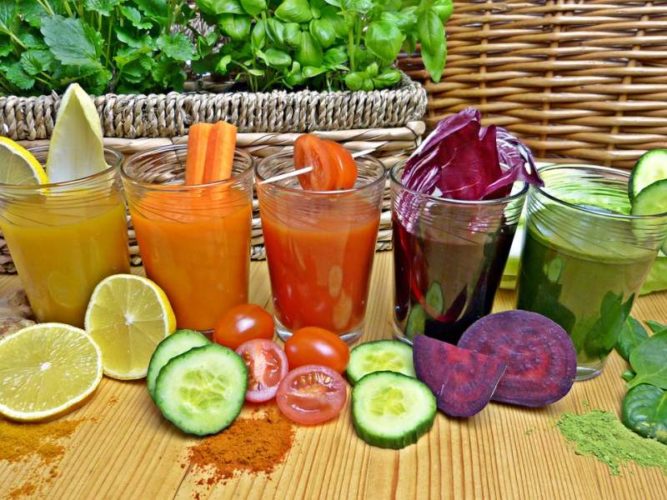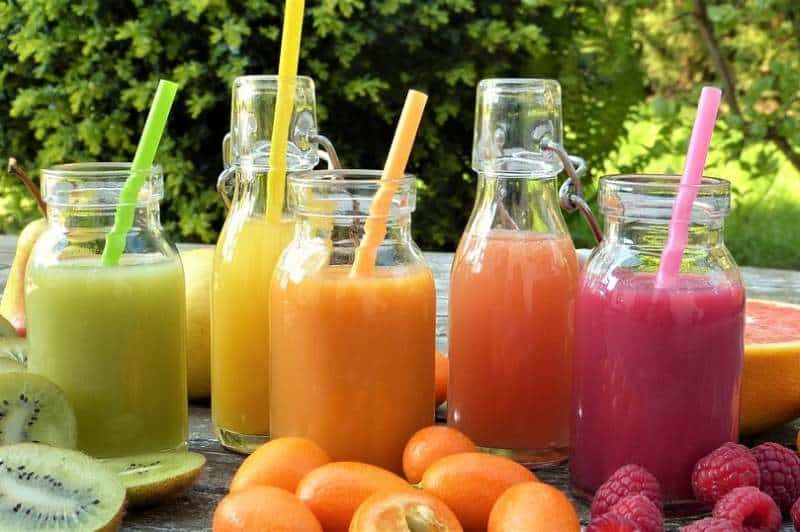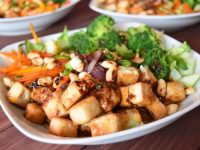In case you haven’t noticed, there’s a growing raw juice trend. Juice stands are dotting corners in Metro areas across the country. The undeniable health benefits of eating raw fruits and vegetables are showing up in headlines and special reports all over the media… still, it takes a little coaxing for many of us to get excited about downing a big cup of fibrous, raw juice. Understandably so.
For those who have considered adding raw juice to their diets, the transition from the drive-thru to the juice stand can be a little daunting.? What juices are good for what?? To add or not to add wheatgrass?? What tastes good?? Certainly, the point of juicing is not simply great taste, but one at least wants to drink something that is palatable.?
Well, great news!? This short guide includes a list of 20 delicious superfoods you absolutely should be juicing.
What is a Superfood?
First things first. What is a superfood? The Harvard Health Center defines “superfood” as food that carries “claims of extraordinary health benefits.” You can’t tell just by looking at which foods pack the most nutritional punch, but there are some easy rules to follow on your next trip to the produce section as you search for these superfoods:
- The greater your produce color palette the better the nutritional value you get
- Choose whole, natural foods that are nutrient-rich (you will get a list of 20 such fruits and veggies later on in this short guide)
- Choose foods that are in-season where you live. They will be fresher and house the nutrition you need for that specific time of the year
- Look for foods that are high in antioxidants
What are Antioxidants?
It’s a good idea to look for foods that are high in antioxidants. Why? Well, antioxidants promote cellular health. They protect your cells from damage caused by exposure to chemicals, pollution, and radiation.
When the human body uses oxygen, a natural by-product of inhale-exhale is oxidative damage. That may not sound like a big thing but think of oxidized (rusted) metal. Consider how the qualities of the metal change when it rusts. The metal reddens and becomes brittle. To prevent this kind of degradation in your body, eat foods high in antioxidants.
To Juice or Not to Juice?
That is the question. Juicing has found its way to the very center of some debate.? On the one hand, those who have gone on strict, all-juice diets for detoxification and weight loss will often swear by the life-changing, ground-shaking advantages of juicing. On the other hand, there are those who view juicing as a quick-fix to the obesity problem in the West. Both sides of the argument are valid.
The truth is, there is no quick-fix for obesity, other than consistently making better dietary choices. Juicing is a fantastic method for getting the nutrition many people tend to forgo on a daily basis.? The fact of the matter is eating whole foods is a much better nutritional option, but it is not nearly as convenient. Let’s face it. Convenience has become a commodity in today’s fast-paced society.
Supplements vs. Juicing
The nutritional supplements market is expected to exceed USD $13 billion in sales by 2014 and that is due, in large part, to the fact that popping a supplement or two every day is a lot easier than figuring out which seasonal foods offer the most nutrition when eaten. Taking supplements can be tricky though. Supplements are not designed to be meal replacements, but even when taken to boost the nutrition in your regular diet, most supplements on the market are not bio-available. That means, your body can’t always break down and use the supplement once it’s been taken.
Raw juice, on the other hand, is immediately available to your body and can satisfy nutritional and caloric needs. So the occasional meal substitution is generally okay.

Deciding What to Juice
This guide includes a list of superfoods based on three criteria – nutritional content, accessibility and taste. The truth is, it doesn’t matter what the nutritional benefits of a certain fruit maybe, if you can’t find it in the produce section or if you can’t stand the taste of it, you won’t juice it.
This guide provides a nice mix of winter and summer produce because there is evidence to support the fact that eating foods that are in-season at the time you consume them, is actually better for you than eating foods that come from halfway around the world.
The Benefits of Eating Local
There are a handful of good reasons why you should stick to consuming locally-grown produce. Our bodies require a variety of different types of nutrients from one season to the next. Eating fresh usually means eating produce that is in-season where you live. Fresh produce is more nutrient-rich than preserved produce because the nutritional value of produce decreases as produce ages. You can bet any produce that had to be shipped to you is being preserved in some way.
You also want the benefit of consuming a colorful produce diet. During the warmer months, proper nutrition includes more hydrating foods with higher water content, like berries. During the cooler months, our bodies require warming foods like squash and potatoes. Many nutritionists are inclined to believe our bodies are designed to need foods when they are naturally available.
Eating only those foods that are seasonal and local is also better for the environment.? The invisible price we pay for convenience is usually a larger carbon footprint. After being treated with pesticides and preservatives, off-season produce is shipped hundreds of miles before it reaches your local supermarket. Keep that in mind as you are out produce shopping.

Top Picks for 20 Superfoods
So here is our list of 20 foods that are nutrient-packed, tasty and readily accessible. All of the fruits and veggies represented on our list are nutritious, popular and tasty. To give you an idea of how to mix the drinks you choose to make, we have divided our top picks of 20 Super Foods into 3 categories:
- Bases are fruits and vegetables that are nutrient-packed and unassuming enough in to be consumed in large quantities
- Flavors – have a more robust and distinguishable flavor to enjoy
- Spikes – are highly-concentrated and strong. These are REALLY strong flavors and should be used in very small amounts just to add personality, flavor or spice to your juice.
Part of the beauty of drinking raw juice is knowing that you can mix your favorite produce together into a powerful and delicious little health cocktail.

Superfood – Bases | Nutritional Value & Health Benefits |
| Carrots | High in vitamin A, beta-carotene, vitamin B and vitamin E.? Cancer-fighting. Antioxidant. |
| Oranges (with peel) | High in vitamin C, calcium, potassium, vitamin A, riboflavin.? Contain beta-carotene and help to regulate blood pressure, promote digestive health, lower cholesterol. |
| Kale | Great source of calcium, lutein,? vitamin K, vitamin A, vitamin C |
| Tomatoes | Packed with vitamin C, potassium, folic acid, vitamin E, vitamin A, vitamin K, niacin, magnesium, phosphorus, copper, beta-carotene. Helps jumpstart metabolism, anti-inflammatory, anti-cancer.? Also contains fiber. |
| Celery | Great source of calcium. Hydrates, alkalizes the body to balance pH.? Aids in digestion and lowers cholesterol. Diuretic. High in vitamins B1, B2 and B6. High in vitamin C, potassium, magnesium, iron, essential amino acids.? Anti-inflammatory. |
| Bok choy | Antioxidant and anti-cancer benefits.? High in vitamin A, vitamin C, vitamin K, vitamin B6, folate, potassium. |
| Cucumbers | Antioxidant, alkalizing, anti-inflammatory, hydrant, diuretic. Great source of vitamins A and C. Help control blood pressure. Great source of folate, some B vitamins, sodium, calcium, manganese, potassium, phosphorus silica, sulfur and chlorine. |
Superfood – Flavours | Nutritional Value & Health Benefits |
| Kiwi | Tasty dietary dynamo! High in vitamin C, vitamin A and vitamin E.? Helps regulate blood sugar.? Supports cardiovascular function. Improves metabolism.? Helps in the absorption of iron. Fantastic source of L-arginine, phosphorus, magnesium, potassium, copper.? |
| Collard Greens | High concentration of vitamin A, vitamin C and calcium |
| Beets | Regulate blood pressure, purify blood, and help create red blood cells.? Help produce glutathione (helps the body to protect itself from and flush out chemical toxins. |
| Pomegranate | High in antioxidants, helps improve transport of oxygen to the heart, may help fight prostate cancer, vitamin C, vitamins B5 and B9, vitamin K, potassium, zinc. |
| Cherries | Packed with antioxidants, anti-inflammatory, pain relief, digestive health.? Rich in vitamin C, vitamin E, potassium, iron, magnesium, folate, fiber, vitamin A, beta-carotene. |
| Green Apples | Very tart in large amounts! Antioxidant. Great source of dietary fiber. Helps regulate blood sugar and encourages a “full” feeling. |
| Blueberries | Promote cognitive function, boost memory, vitamin C, vitamin K, fiber, antioxidant, anti-cancer,? |
| Strawberries | Natural tooth whitener. High vitamin C content, a significant source of fiber. antioxidant properties, anti-inflammatory, anti-cancer, vitamin K, potassium, magnesium |
Superfood – Spikes | Nutritional Value & Health Benefits |
| Honey | Okay.? This isn’t produced, but it’s still amazing, tasty and easily accessible.? Amazing immunity booster.? Anti-inflammatory, anti-bacterial, antimicrobial, throat soother, cough suppressant, promotes relaxation. |
| Lemons | High in vitamin C, fight bad breath, antibacterial, soothe a sore throat, fight urinary tract infections, reduce stress, control blood pressure, aid in digestion |
| Cranberries | High in antioxidants, prevents and remedies urinary tract infections, prevents the formation of plaque on teeth, helps maintain healthy cholesterol levels |
| Ginger | Very spicy with a distinct taste.? Promotes gastrointestinal balance, reduces nausea, anti-inflammatory, pain reliever,?? antioxidant, anti-tumor effects on cells. Great for women as it has been proven to kill diseased cells in women with ovarian cancer. |
| Hot Chili Peppers | Extremely spicy! Use carefully. A superb source of vitamin C, vitamin B-complex, vitamin A. Antioxidant (the hotter the pepper, the more antioxidant properties it has), promotes the release of endorphins. Contains capsaicin (which is believed to have anti-bacterial, anti-carcinogenic, analgesic and anti-diabetic benefits) |
One Last Suggestion…
To add a little body to your raw juice, blend it! Blended drinks and smoothies are a great way to make sure you are getting enough fiber (which is often found in the skin of your fruits and vegetables) into your drink. Need some healthy ideas on what to blend with your juice? Try these:
| Ice Frozen banana Frozen spinach Frozen broccoli crown Frozen grapes Frozen mango Frozen yogurt | Plain Greek yogurt Fruit sorbet Almond milk Soy milk (plain or vanilla) Natural almond butter Natural peanut butter | Gala apples Cantaloupe Honeydew melons Watermelon Tomatillo Pineapple Star fruit | Crushed almonds Grape seeds Echinacea leaves Granola Garlic (grated or juiced as in very small amounts) Flax seeds |
Sources:
Superfoods or Superhype? https://www.hsph.harvard.edu/nutritionsource/superfoods/
16 Superfoods That Are Worthy of the Title https://www.healthline.com/nutrition/true-superfoods
10 superfoods to boost a healthy diet https://www.health.harvard.edu/blog/10-superfoods-to-boost-a-healthy-diet-2018082914463
What Are Superfoods? https://www.livescience.com/34693-superfoods.html
- Where Are Tomatoes Native To? - August 1, 2022
- Are Organic Chickpeas Better? - July 26, 2022
- How Being Vegan Helps Climate Change - July 24, 2022




